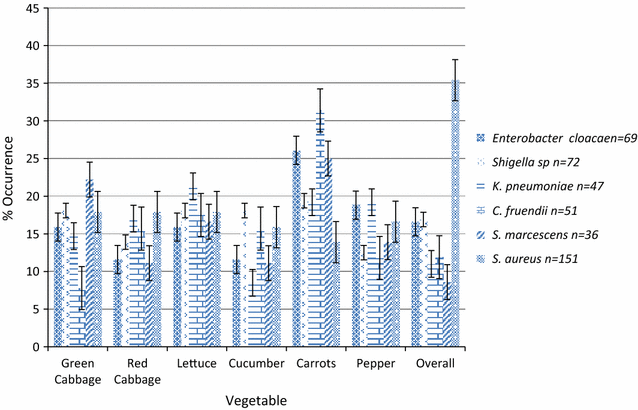Bacterial and parasitic contaminants of salad vegetables sold in markets in Fako Division, Cameroon and evaluation of hygiene and handling practices of vendors
- PMID: 29409524
- PMCID: PMC5801804
- DOI: 10.1186/s13104-018-3175-2
Bacterial and parasitic contaminants of salad vegetables sold in markets in Fako Division, Cameroon and evaluation of hygiene and handling practices of vendors
Abstract
Objective: Increase in awareness of the health benefits of vegetables has resulted in an increase in consumption. Many vegetables are consumed raw to retain the natural taste and heat labile nutrients. The safety of raw vegetables is a great concern. We investigated the bacteriological and parasitological quality of salad vegetables sold in three major markets in Fako Division Cameroon, the hygiene and preservation practices of vendors and determined the antimicrobial sensitivity of bacterial isolates, to provide data that could be used to improve food safety and safeguard public health.
Results: Bacterial contamination was high. Mean aerobic bacteria counts ranged from 2.5 × 106 to 15 × 106 cfu/g, total coliform counts from 4 to > 2400/g and fecal coliforms < 3 to 1100/g. Six bacterial species were isolated among which Staphylococcus aureus (35.4%) predominated while Serratia marcescens (8.5%) was the least. Bacteria showed high resistance to erythromycin (87.6%). Ten parasitic organisms were detected. Balantidium coli (25.6%) and Entamoeba spp. (21.7%) predominated. Contamination was highest in lettuce and lowest in green pepper. Hygiene and vegetable preservation practices of vendors were poor and could aggravate contamination. Contamination of fresh salad vegetables with pathogenic bacteria and parasites could be a food safety concern in study area.
Keywords: Antibiotic resistance; Cameroon; Hygiene practices; Intestinal parasites; Pathogenic bacteria; Salad vegetables.
Figures


Similar articles
-
Detections of antimicrobial resistance phenotypes and extended-spectrum beta-lactamase (ESBL)- producing Salmonella spps and Escherichia coli O157:H7 in raw vegetables and fruits from open markets in Jimma town, Ethiopia and evaluation of hygiene and handling practices of vendors.One Health Outlook. 2025 Feb 1;7(1):2. doi: 10.1186/s42522-024-00125-5. One Health Outlook. 2025. PMID: 39891306 Free PMC article.
-
Parasitic contamination of fresh vegetables sold at central markets in Khartoum state, Sudan.Ann Clin Microbiol Antimicrob. 2016 Mar 11;15:17. doi: 10.1186/s12941-016-0133-5. Ann Clin Microbiol Antimicrob. 2016. PMID: 26968696 Free PMC article.
-
Aerobic bacterial, coliform, Escherichia coli and Staphylococcus aureus counts of raw and processed milk from selected smallholder dairy farms of Zimbabwe.Int J Food Microbiol. 2011 Dec 2;151(2):223-8. doi: 10.1016/j.ijfoodmicro.2011.08.028. Epub 2011 Sep 10. Int J Food Microbiol. 2011. PMID: 21944662
-
Parasitic contamination in vegetables for human consumption: a systematic review and meta-analysis.Rev Bras Parasitol Vet. 2024 Sep 6;33(3):e002824. doi: 10.1590/S1984-29612024040. eCollection 2024. Rev Bras Parasitol Vet. 2024. PMID: 39258598 Free PMC article.
-
Food Safety in Sub-Sahara Africa, An insight into Ghana and Nigeria.Environ Health Insights. 2022 Dec 14;16:11786302221142484. doi: 10.1177/11786302221142484. eCollection 2022. Environ Health Insights. 2022. PMID: 36530486 Free PMC article. Review.
Cited by
-
Prevalence of Antibiotic Resistome in Ready-to-Eat Salad.Front Public Health. 2020 Mar 25;8:92. doi: 10.3389/fpubh.2020.00092. eCollection 2020. Front Public Health. 2020. PMID: 32269985 Free PMC article.
-
Parasitological assessment of some fruits and vegetables commonly sold in retail outlets in the Mfoundi Division of Cameroon.Parasite Epidemiol Control. 2023 Jun 14;22:e00313. doi: 10.1016/j.parepi.2023.e00313. eCollection 2023 Aug. Parasite Epidemiol Control. 2023. PMID: 37416760 Free PMC article.
-
Evaluation of the Effect of Wastewater Irrigation on the Microbiological Quality of Vegetables in Northeast Ethiopia: Implication for Food-Borne Infection and Intoxications.Environ Health Insights. 2022 Oct 11;16:11786302221127856. doi: 10.1177/11786302221127856. eCollection 2022. Environ Health Insights. 2022. PMID: 36249121 Free PMC article.
-
Detection of human intestinal protozoan parasites in vegetables and fruits: a review.Parasit Vectors. 2020 Jul 29;13(1):380. doi: 10.1186/s13071-020-04255-3. Parasit Vectors. 2020. PMID: 32727529 Free PMC article. Review.
-
When washing is not enough: a cross-disciplinary analysis of hygiene and handling practices among vegetable traders in Nigeria.Food Secur. 2025;17(3):657-669. doi: 10.1007/s12571-025-01531-x. Epub 2025 Mar 29. Food Secur. 2025. PMID: 40438615 Free PMC article.
References
-
- World Health Organisation (WHO). Increasing fruit and vegetable consumption to reduce the risk of non-communicable diseases. 2016. www.who.int/elena/titles/fruits_vegetables_ncds/en/. Accessed 27 Dec 2016.
-
- WHO/FAO. WHO and FAO announce global initiative to promote consumption of fruit and vegetables. 2016. www.who.int/mediacentre/news/releases/2003/pr84/en/2003. Accessed 27 Dec 2016.
MeSH terms
Substances
LinkOut - more resources
Full Text Sources
Other Literature Sources
Medical
Molecular Biology Databases
Miscellaneous

